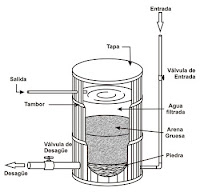Shade balls are California's most mesmerizing water-saving trick
Those are municipal workers in Los Angeles pouring "shade balls" into one of the city's reservoirs. The black plastic balls help maintain water quality by blocking sunlight, thereby preventing hazardous reactions with the chlorine and bromide in the water. (The shade balls also cut down on evaporation, though this is a relatively minor benefit.)
Yes, shade balls. Fun to say. Fun to watch. But also surprisingly useful
A brief history of shade balls
Black plastic shade balls have been used for all sorts of purposes over the years. Catherine Kavanaugh of Plastic News reports that they've been deployed to "keep birds out of water near airport runways, control vapors in industrial ammonia tanks, or stop water from evaporating at petroleum operations."
And in recent years, the city of Los Angeles has realized that shade balls can be useful for protecting drinking water from contaminants. Back in 2007, the LA Department of Water and Power discovered it had a troubling water-quality problem. Its reservoirs contained a fair amount of bromide, which occurs naturally in groundwater. They alsocontained chlorine, which was being added to disinfect drinking water. When bromide and chlorine react with sunlight, they form bromate, a suspected human carcinogen. Not good. Elevated bromate levels had been detected at the Silver Lake, Ivanhoe, and Elysian reservoirs.
Mulling its options, the city decided it wouldshield some of its reservoirs from the sun. And shade balls were a low-cost option. Ivanhoe got its balls in 2008.* Then, this week, the city finished pouring 96 million plastic balls into the Los Angeles Reservoir at Sylmar, all at the (relatively) low cost of $34.5 million, much cheaper than initial estimates. The balls are weighted with water so that they stay fixed in place, and they're expected to last 10 years before getting recycled.
(By the way, balls are only part of LA's water-quality plan. The city is also building a new indoor reservoir to replace Silver Lake and Ivanhoe — both of which had lots of contamination issues beyond bromate, including birds, runoff, and algae.)
There's also a small bonus. Shade balls help prevent some evaporation, a source of water loss in California's vast reservoir system. "By reducing evaporation, these shade balls will conserve 300 million gallons of water each year, instead of just evaporating into the sky. That's 300 million gallons to fight this drought," LA Mayor Eric Garcetti said at a recent press conference.
To be clear, 300 million gallons a year isn't a ton of water in the grand scheme of things — Los Angeles consumed 13.6 billion gallons of water this past June alone. Still, every little bit helps. And did we mention shade balls are fun to watch?
* Correction: Apologies, I got caught up in ball-mania. Silver Lake is not one of the reservoirs getting balls (it's just being taken offline and will soon be replaced by the Headworks project).
http://www.vox.com



Comentarios
Publicar un comentario